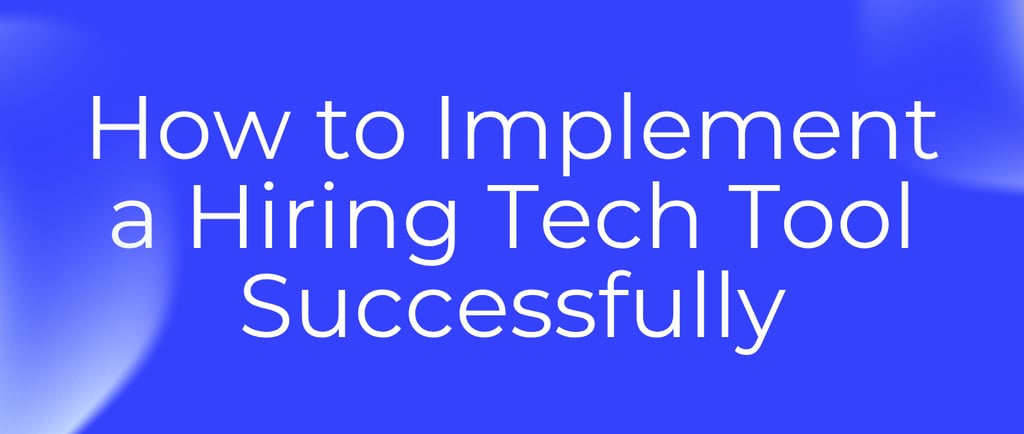How to Implement a Hiring Tech Tool Successfully
Learn how to roll out hiring technology step by step—without disrupting your team or candidate experience. Practical tips for HR teams launching new tools.
Yeli Peña
10/7/20253 min read


A Hands-On Guide for HR Teams
Choosing a smart hiring tool is just the start. The real challenge? Making it work inside your team—without slowing anyone down or confusing candidates.
In this guide, you’ll get a clear, realistic playbook: what to do before, during, and after implementation. Use it as your map so your tech actually delivers value from day one.
1. Define Why You Need the Tool (and What Success Looks Like)
Before you even pick or install software, get clear on why you’re doing it.
What hiring pain are you solving? (e.g. “too slow to fill roles,” “candidates drop out mid-process,” “recruiters drowning in manual tasks”)
What would “better” look like? (e.g. “shorter time-to-fill,” “less back-and-forth scheduling,” “higher candidate satisfaction”)
How does that support business goals? (lower cost per hire, higher productivity, better employer brand)
When you connect your tool to real outcomes, it’s easier to get buy-in from your team and leadership.
2. Map Your Current Hiring Workflow
You can’t improve what you don’t understand.
List every step: sourcing, screening, interviewing, offers, onboarding
Note which tools or systems you currently use
Flag delays, bottlenecks, drops in candidate engagement
This “before” baseline will let you measure how much better (or worse) things become after launch.
3. Get Stakeholders on Board Early
Tech adoption fails when people feel it’s forced on them.
Invite recruiters, hiring managers, HR ops to demos
Assign a project lead (someone with cross-team visibility)
Bring your IT/compliance people in early—so integrations, security, data flow don’t surprise you
Early involvement builds ownership and makes roll-out smoother.
4. Check Integrations & Compatibility
Your new tool must play nicely with what you already have. Here are some of the best applicant tracking software.
Can it connect with your ATS, calendar, CRM, Slack/Teams?
Is it mobile-friendly for both candidates and recruiters?
What data does it capture, and how is it shared across systems?
Ask for technical documentation before fully committing
The new tech tool must easily integrate with your ATS and HR software. If it doesn’t integrate, you might end up duplicating work rather than reducing it. Ask for our integrations
5. Pilot First—Don’t Launch Everywhere at Once
Think of this as a dress rehearsal, not opening night.
Pick one team, department, or region to pilot
Run the tool side by side with your old way
Collect feedback from users and candidates
Compare performance against your baseline
A pilot lets you discover issues, iterate, and build internal champions before going company-wide.
6. Design a Training & Onboarding Plan People Will Use
Even an amazing tool fails if nobody knows how to use it.
Run short, role-specific training sessions
Make quick video snippets or visual guides
Offer hands-on support during the first few weeks
Use regular check-ins (weekly, early on) to capture questions, adjust
Training should be frictionless, helpful, and timely.
7. Measure What Matters: KPIs & Feedback
To prove this tool works, track data from day one.
Are you hitting the goals you defined earlier? (e.g., time-to-fill, drop-off rates, recruiter time saved)
Are candidates having smoother experiences?
Are recruiters doing less tedious admin work?
Check results at 30, 60, and 90 days. Share them back with your team and leadership—success is easier to sustain when it’s visible.
Check 5 Recruitment KPIs Every HR Director Should Track for Faster, Higher-Quality Hiring
8. Watch for Warning Signs (And Act Early)
Here are red flags to catch early:
The tool adds steps instead of removing them
Recruiters revert to old spreadsheets
Reporting or data isn’t clear or trustworthy
Candidates get confused, abandon processes
If you see any of these, pause, rewind, and fix either training, configuration, or process alignment. It's important to take care of the candidates' experience; check some stats.
Conclusion: The Tech Is Only As Good As Your Roll-Out
A slick tool won’t help if it's deployed badly. But with a well-planned rollout, stakeholder support, training, and clear metrics, you can turn it into a differentiator.
If you ever want help selecting, rolling out, or debugging your hiring stack, Nova Hiring is here for HR teams looking to scale without chaos. Contact our team now!
Navigation
Subscribe to our newsletter
AI-powered hiring automation: interview every candidate, hire faster, decide smarter.
Offices in Barcelona & Valencia
Nova Hiring 2025. All rights reserved.
Contact us


info@novahiring.com


